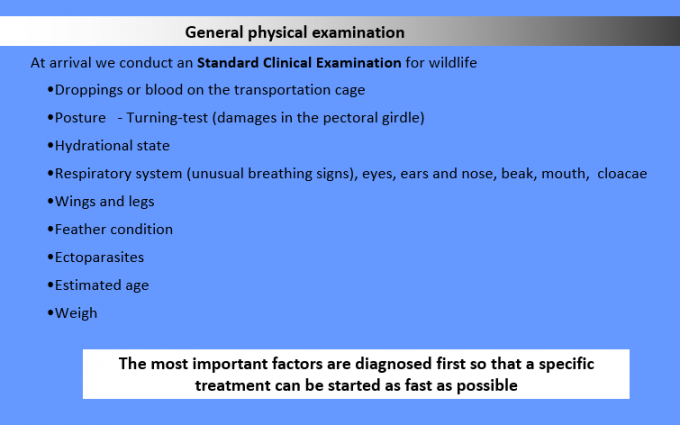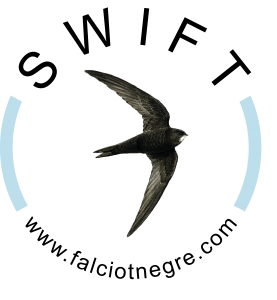Clinical examination
![]() Wait a few seconds for the videos to load
Wait a few seconds for the videos to load
CLINICAL EXAMINATION Video 2 of 2
Gepostet von Falciot Vencejo Swift Rehabilitation am Sonntag, 28. Juni 2015

Before starting the clinical examination it is important to obtain as much information as possible from the donor. This information may help to identify the casualty cause and help on the prognosis.
It was found in a dirty water puddle – that’s why it is covered by oil;
it was found in a cat’s mouth – so external wounds are observed;
it was found in a chimney or kitchen estractor? – So the dust covering the bird is soot or oil;
it was found near a window? –possibly the bird hit the window and that’s why the bird was stunned.
Was the bird rescued from a nest where repairs work was conducted? That may help to let authorities know in order it stop further damage in other nests.
How long has been kept by the donor?
Has the donor provided any food?
Has de donor provided any drug?
Other relevant questions will occur to the experienced rehabilitator.
EXAMINATION OF THE TRANSPORTING BOX
-DROPPINGS: The droppings reveal much information and are a good indicator as to the health of the bird. A normal excreta consist of a dark-coloured central part and an off-white surrounding portion and a little clear fluid.
-BLOOD in the cage: It may come from an injury to the wings, from the cloacae orifice, a damaged growing feather, etc.
-Rest of FOOD: If we cannot get information from the donor, we can guess how the bird was fed (in case was force fed).
-PARASITES: external parasites are often found, better assessed with the bird on hand.
OBSERVATION OF THE PATIENT
-GENERAL OBSERVATION: even when usually swifts are quite passive, we can observe the posture and attitude. Alert or depressed? Showing normal movements or normal posture or convulsing? Is the head dropping or straight?
-EYES: the bird should have a full-rounded bright eye. An eye slightly oval means the bird is not fully alert.
-FEATHERS: the plumage sleek and lie flat over the body. If the feathers are ruffled, the bird is trying to conserve heat.
-BREATHING ABNORMALITIES: sounds of breathing may indicate the presence of blood or mucus in the mouth or trachea
-CENTRAL NERVOUS SYSTEM SIGNS: a bird may show torticollis, circling, paralysis, ataxia, spams, etc.
-WING INJURIES: are the wings symmetrical? The functionality of the limbs is assessed with the bird restrained as swift are usually very passive when placed on a box.
PHYSICAL EXAMINATION OF THE RESTRAINED BIRD
Physical examination should not be performed if the bird shows any open-mouth breathing during handling. Allow the bird rest and calm before further handling.
-FRACTURES: fractures are life-threatening injuries. Birds need fully functional limbs in order to be released back to nature.
-FEATHERS AND PLUMAGE: the plumage should be a good, even, dense colour, with the barbules together so the feathering gives a uniform outline to the body form. Malformed and curled flight feathers are usually the result of faulty nutrition, if not a traumatic cause. Observe if there are lines of decreased density and weakness across the vane of the feather, these lines are known as “stress marks” and are caused by release of endogenous corticosterone under physical stressors such as food restriction or poor nutritional condition at the time of the feather growth.
-PARASITES: a careful search of the plumage will show any mite situated along the feather shaft or on the skin surface. Mite infestation may lead to invasion the feather follicle and damage and loss of the feather. Check also in the ears.
-EYES: you may observe a variety of conditions. Is the bird tending to hold one eye closed? Look for lacerations, scratches, haemorrhage, conjunctivitis, discharge, swelling of the eyelids. Fluorescein stain will help to examine for corneal ulcers, and an ophthalmoscope to examine the retina.
-MUCOSES AND SKIN: check the colour of the oral mucous membranes, parasites (white plaques) or blood within the mouth. How is the saliva? Stringy saliva suggests significant dehydration. Check nares and bill for discharge. Check the skin, a wrinkled skin over the abdomen denotes important dehydration.
-BEAK: fractures are sometimes found.
-THROAT: check difficulty in swallowing (drop of water), lacerations, foreign bodies, plaques, swellings, discharges, abscesses. Check breath odour (sweet smell could be Candida yeast infection)
-BODY CONDITION: assessed by palpating the muscle mass of the breast. Check areas of scabbing, feather loss, bruising or damage. Blow air to part feathers and look for lacerations, bruising and subcutaneous emphysema. The abdomen should feel soft, firm or hard-feeling abdominal organs may denote markedly dehydration.
-VENT: check the vent for lesions, diarrhoea, crusted dropping. Gently wash the vent with warm water if necessary.
-LIMBS AND JOINTS: flex and extend gently each joint separately, noting presence of paint, swelling, heat, deformities, asymmetries, dislocation, crepitus, limitation of motion or fractures.
-TURNING-TEST: the bird is turned on its back in order to observe if can turn back to the breast position, providing information of possible pectoral girdle damage.
In case of suspicion of any contagious condition, the patient should be kept in a separate housing box and use of exclusive material.
If a wild bird is measured not being able to function and survive in the wild, euthanasia has to be considered.
[/paragraph]
